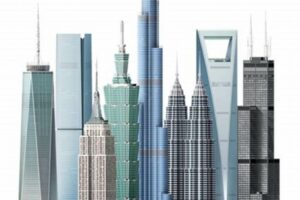Within the construction industry, insulation in skyscrapers has become a crucial component for ensuring energy efficiency and occupant comfort in high-rise buildings. It involves the use of various materials and techniques to reduce the transfer of heat, sound, and moisture, thereby creating a more sustainable and habitable environment within these towering structures.
The importance of insulation in skyscrapers cannot be overstated. It helps regulate indoor temperatures, reducing energy consumption for heating and cooling. Insulation also plays a vital role in soundproofing, minimizing noise pollution from both external sources and within the building itself. Additionally, proper insulation can prevent moisture buildup, which can lead to mold growth, structural damage, and poor air quality.
In this article, we will delve deeper into the types of insulation used in skyscrapers, their effectiveness, and the latest advancements in insulation technology. We will also explore the challenges faced in insulating high-rise buildings and the innovative solutions employed to overcome them. Ultimately, we aim to provide a comprehensive understanding of the essential role that insulation plays in creating sustainable, comfortable, and energy-efficient skyscrapers.
1. Thermal insulation
Thermal insulation is a crucial component of insulation in skyscrapers, as it plays a vital role in reducing heat transfer and lowering energy consumption. Skyscrapers, with their vast surface areas and complex architectural designs, are particularly susceptible to heat gain and loss, which can lead to significant energy wastage. Thermal insulation helps to mitigate these issues by creating a barrier between the interior and exterior of the building, preventing the transfer of heat through conduction, convection, and radiation.
The effectiveness of thermal insulation in skyscrapers is measured by its thermal resistance, or R-value. A higher R-value indicates a greater ability to resist heat flow. Common insulation materials used in skyscrapers include fiberglass, cellulose, and spray foam, each with varying R-values and properties. The type and thickness of insulation chosen will depend on factors such as the climate, building design, and energy efficiency goals.
Properly installed thermal insulation can significantly reduce energy consumption in skyscrapers. By minimizing heat transfer, it reduces the demand on heating and cooling systems, leading to lower energy bills and a smaller carbon footprint. Additionally, thermal insulation contributes to occupant comfort by maintaining a more stable indoor temperature, reducing the risk of overheating or excessive cooling.
In summary, thermal insulation is an essential aspect of insulation in skyscrapers, offering numerous benefits, including reduced energy consumption, improved occupant comfort, and environmental sustainability. By carefully considering the type and thickness of insulation used, architects and builders can design skyscrapers that are energy-efficient and comfortable for occupants.
2. Acoustic insulation
In the context of insulation in skyscrapers, acoustic insulation plays a critical role in minimizing noise pollution and enhancing privacy for occupants. Skyscrapers, by nature of their height and proximity to other buildings and transportation hubs, are often exposed to various noise sources that can negatively impact the living and working environment within.
- Soundproofing: Acoustic insulation materials are strategically placed within walls, floors, and ceilings to block or absorb sound waves, reducing noise transmission between different areas of the skyscraper. This is particularly important in high-traffic areas such as lobbies, elevators, and mechanical rooms.
- Privacy enhancement: Acoustic insulation also contributes to privacy by minimizing sound leakage between adjacent units or rooms. This is especially important in residential skyscrapers, where occupants desire a peaceful and private living space.
- Improved concentration and productivity: In commercial skyscrapers, acoustic insulation helps reduce noise distractions, improving concentration and productivity for office workers. This is achieved by reducing noise from neighboring offices, mechanical equipment, and exterior sources.
- Compliance with regulations: Many cities have noise ordinances that set limits on acceptable noise levels in buildings. Acoustic insulation helps skyscrapers comply with these regulations, ensuring a comfortable and compliant living and working environment for occupants.
Overall, acoustic insulation is an essential component of insulation in skyscrapers, contributing to occupant comfort, privacy, and productivity. By carefully incorporating acoustic insulation materials and techniques, architects and builders can design skyscrapers that provide a peaceful and enjoyable living and working environment amidst the hustle and bustle of urban life.
3. Moisture control
In the context of insulation in skyscrapers, moisture control plays a pivotal role in preventing mold growth, structural damage, and poor air quality. Skyscrapers, with their complex architectural designs and vast surface areas, are particularly susceptible to moisture accumulation, which can lead to a host of problems if not properly addressed.
- Mold growth: Moisture buildup can create a breeding ground for mold, which can cause respiratory problems, allergies, and other health issues for occupants. Insulation helps prevent mold growth by controlling moisture levels within the building.
- Structural damage: Excess moisture can also lead to structural damage, weakening building materials such as wood, metal, and concrete. Insulation acts as a barrier, preventing moisture from penetrating these materials and causing damage.
- Poor air quality: Moisture accumulation can contribute to poor indoor air quality, making it stale and uncomfortable for occupants. Insulation helps regulate moisture levels, reducing the risk of stagnant air and promoting good air quality.
Effective moisture control in skyscrapers requires a comprehensive approach that includes proper insulation, ventilation, and moisture management strategies. By incorporating these measures, architects and builders can create skyscrapers that are healthy, comfortable, and durable.
4. Fire safety
Fire safety is a critical aspect of insulation in skyscrapers, as it plays a vital role in slowing the spread of fire and protecting occupants and the building itself. Skyscrapers, with their vast heights and complex architectural designs, pose unique fire safety challenges. Insulation helps address these challenges by providing a barrier against the spread of flames and smoke.
One of the primary functions of insulation in skyscrapers is to prevent the spread of fire through conduction. When a fire occurs, insulation acts as a buffer, slowing down the transfer of heat to adjacent areas. This delay can provide valuable time for occupants to evacuate and for firefighters to respond.
In addition to preventing the spread of fire, insulation also helps protect the building’s structural integrity. By slowing down the spread of heat, insulation can prevent steel beams and other structural elements from reaching critical temperatures that could lead to collapse. This protection is particularly important in skyscrapers, where structural failure could have catastrophic consequences.
To ensure effective fire safety in skyscrapers, insulation materials must meet strict fire safety standards. These standards include requirements for flammability, smoke production, and toxicity. By using fire-resistant insulation materials, architects and builders can create skyscrapers that are safer for occupants and more resistant to fire damage.
5. Sustainability
In the context of insulation in skyscrapers, sustainability plays a crucial role in reducing a building’s carbon footprint and contributing to green building certifications. Green building certifications, such as LEED (Leadership in Energy and Environmental Design), recognize buildings that meet specific environmental performance standards, including energy efficiency, water conservation, and sustainable materials.
Insulation is a key component of sustainable skyscraper design, as it directly impacts the building’s energy consumption. By reducing heat transfer and improving energy efficiency, insulation helps lower the building’s carbon footprint and operating costs. This is particularly important for skyscrapers, which have large surface areas and complex architectural designs that can lead to significant energy loss.
In addition to energy efficiency, insulation also contributes to sustainability by reducing the use of non-renewable resources. By minimizing the need for heating and cooling systems to maintain comfortable indoor temperatures, insulation helps conserve fossil fuels and reduce greenhouse gas emissions.
Real-life examples of sustainable skyscrapers that incorporate innovative insulation techniques include:
- The Burj Khalifa in Dubai, which uses a combination of high-performance glazing and insulation to minimize heat gain and reduce energy consumption.
- The One World Trade Center in New York City, which features a double-skin facade with an insulated cavity to improve energy efficiency and reduce the building’s carbon footprint.
- The Bank of America Tower in New York City, which uses a reflective curtain wall system and high-performance insulation to reduce heat gain and improve energy efficiency.
By understanding the connection between sustainability and insulation in skyscrapers, architects, engineers, and building owners can design and construct skyscrapers that are environmentally friendly, energy-efficient, and contribute to a more sustainable built environment.
6. Cost-effectiveness
In the context of insulation in skyscrapers, cost-effectiveness plays a crucial role in justifying the investment in insulation and realizing long-term energy savings. While the initial installation of insulation may require upfront costs, these costs are typically outweighed by the substantial energy savings achieved over the building’s lifespan.
Skyscrapers, with their vast surface areas and complex architectural designs, are particularly susceptible to heat loss and gain. Proper insulation acts as a barrier, reducing the amount of energy required to maintain comfortable indoor temperatures. This reduction in energy consumption leads to lower utility bills and operating costs for the building owners and tenants.
Real-life examples demonstrate the cost-effectiveness of insulation in skyscrapers. The Empire State Building in New York City, after undergoing a major energy retrofit that included insulation upgrades, achieved a 38% reduction in energy consumption. Similarly, the Burj Khalifa in Dubai, one of the world’s tallest buildings, utilizes a combination of high-performance glazing and insulation to minimize heat gain and reduce energy costs.
Understanding the cost-effectiveness of insulation in skyscrapers is essential for building owners and developers seeking to make informed decisions about their investment. By considering the long-term energy savings and comparing them to the upfront installation costs, they can justify the investment in insulation and reap the financial benefits over the building’s lifetime.
7. Advanced materials
Advanced materials play a pivotal role in the continuous innovation of insulation materials and techniques used in skyscrapers. The unique challenges posed by high-rise buildings, such as extreme weather conditions, complex architectural designs, and energy efficiency demands, necessitate the development of advanced insulation solutions.
One significant advancement is the use of vacuum insulation panels (VIPs). VIPs consist of a core of silica powder or aerogel sandwiched between two reflective barriers. This design creates a near-perfect vacuum, providing exceptional thermal insulation with minimal thickness. VIPs are particularly valuable in skyscrapers where space is often at a premium.
Another innovation is the development of phase-change materials (PCMs). PCMs have the ability to absorb and release heat as they undergo phase changes. By incorporating PCMs into insulation materials, the thermal mass of the building is increased, leading to reduced temperature fluctuations and improved energy efficiency.
Furthermore, advancements in nanotechnology have led to the creation of aerogels, which are lightweight, porous materials with ultra-low thermal conductivity. Aerogels can be used as insulation in various forms, including blankets, panels, and loose-fill.
The practical significance of these advanced materials lies in their ability to enhance the performance of insulation in skyscrapers. By providing superior thermal insulation, reducing energy consumption, and improving occupant comfort, these materials contribute to the sustainability and efficiency of high-rise buildings.
FAQs on Insulation in Skyscrapers
This section addresses frequently asked questions and misconceptions regarding insulation in skyscrapers, providing clear and informative answers.
Question 1: Why is insulation crucial in skyscrapers?
Insulation in skyscrapers is paramount for several reasons. It optimizes energy efficiency by reducing heat transfer, leading to lower energy consumptio
n for heating and cooling. Moreover, it enhances occupant comfort by maintaining stable indoor temperatures and minimizes noise pollution, creating a more tranquil and comfortable living and working environment.
Question 2: What types of insulation are commonly used in skyscrapers?
A range of insulation materials is employed in skyscrapers, including fiberglass, cellulose, spray foam, and vacuum insulation panels (VIPs). Each material offers unique properties and R-values, and the choice depends on factors such as climate, building design, and energy efficiency goals.
Question 3: How does insulation contribute to sustainability in skyscrapers?
Insulation plays a significant role in promoting sustainability in skyscrapers. By reducing energy consumption, it lowers greenhouse gas emissions and contributes to a smaller carbon footprint. Additionally, insulation helps regulate indoor air quality, reducing the risk of mold growth and ensuring a healthier indoor environment for occupants.
Question 4: Is insulation cost-effective for skyscrapers?
Investing in insulation for skyscrapers can be highly cost-effective over the long term. While initial installation costs may be involved, the substantial energy savings achieved throughout the building’s lifespan typically outweigh these costs. Reduced energy consumption translates to lower utility bills and operating expenses, providing a positive return on investment.
Question 5: Are there any innovative insulation materials or techniques for skyscrapers?
Ongoing advancements in insulation technology have led to the development of innovative materials and techniques for skyscrapers. These include vacuum insulation panels (VIPs), phase-change materials (PCMs), and aerogels, which offer exceptional thermal insulation, improved energy efficiency, and enhanced occupant comfort.
Question 6: How does insulation contribute to fire safety in skyscrapers?
Insulation plays a crucial role in fire safety by acting as a barrier against the spread of flames and smoke. Fire-resistant insulation materials help slow down heat transfer, providing valuable time for occupants to evacuate and firefighters to respond. This protection is particularly critical in skyscrapers, where the height and complexity of the building pose unique fire safety challenges.
In summary, insulation is an integral component of skyscrapers, contributing to energy efficiency, occupant comfort, sustainability, cost-effectiveness, fire safety, and overall building performance. By understanding the importance and benefits of insulation, architects, engineers, and building owners can design and construct skyscrapers that are environmentally friendly, energy-efficient, and provide a comfortable and safe living and working environment for occupants.
Transition to the next article section:
Continue reading to explore the specific materials and techniques used in insulation for skyscrapers, including their properties, applications, and the latest advancements in this field.
Tips on Insulation in Skyscrapers
To ensure effective insulation in skyscrapers, consider the following tips:
Tip 1: Choose the Right Insulation Material
Selecting the appropriate insulation material is crucial. Factors to consider include climate, building design, and energy efficiency goals. Common materials used in skyscrapers include fiberglass, cellulose, spray foam, and vacuum insulation panels (VIPs), each with unique properties and R-values.
Tip 2: Install Insulation Properly
Proper installation is essential for optimal insulation performance. Ensure that insulation is fitted snugly and without gaps or voids. This prevents air infiltration and maximizes thermal resistance.
Tip 3: Consider the Building Envelope
The building envelope, including walls, roof, and windows, should be considered as a whole when planning insulation. A comprehensive approach ensures that all areas are adequately insulated to minimize heat loss and gain.
Tip 4: Address Thermal Bridging
Thermal bridging occurs when heat is transferred through conductive elements in the building envelope. Identify and address thermal bridges, such as metal studs or concrete balconies, by using thermal breaks or insulation.
Tip 5: Utilize Advanced Insulation Techniques
Stay updated on the latest insulation advancements, such as vacuum insulation panels (VIPs) and phase-change materials (PCMs). These technologies offer exceptional thermal performance and can enhance the overall energy efficiency of the building.
Tip 6: Conduct Regular Inspections and Maintenance
Regular inspections and maintenance are essential to ensure the continued effectiveness of insulation. Check for any damage, moisture accumulation, or gaps that may compromise insulation performance.
Tip 7: Seek Professional Advice
Consult with qualified professionals, such as architects, engineers, or insulation contractors, for guidance on insulation selection, installation, and maintenance. Their expertise can help optimize insulation performance and achieve desired energy efficiency goals.
Summary
Effective insulation in skyscrapers requires careful planning, proper installation, and ongoing maintenance. By following these tips, architects, engineers, and building owners can design and construct high-rise buildings that are energy-efficient, comfortable, and environmentally sustainable.
Conclusion
Insulation in skyscrapers plays a vital role in energy efficiency, occupant comfort, sustainability, and overall building performance. By understanding the importance of insulation and implementing effective insulation strategies, architects, engineers, and building owners can create high-rise buildings that are environmentally friendly, cost-effective, and provide a comfortable and safe living and working environment for occupants.
As technology continues to advance, we can expect to see even more innovative insulation materials and techniques emerge, further enhancing the performance of skyscrapers and contributing to a more sustainable built environment. By embracing these advancements and incorporating insulation as an integral part of skyscraper design, we can create high-rise buildings that meet the demands of the future and contribute to a more sustainable and livable urban environment.







